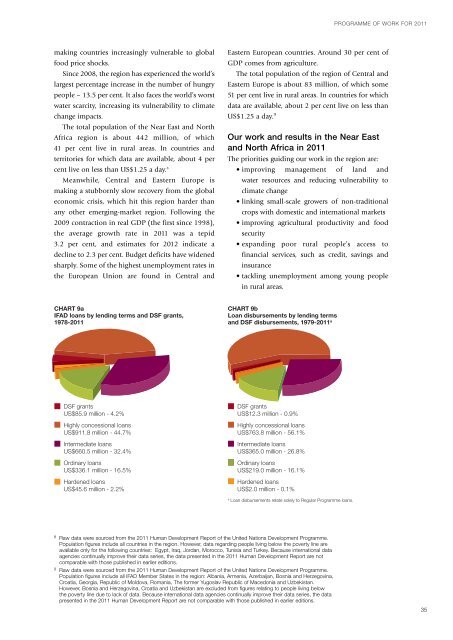ANNUAL REPORT 2011 - IFAD
ANNUAL REPORT 2011 - IFAD
ANNUAL REPORT 2011 - IFAD
You also want an ePaper? Increase the reach of your titles
YUMPU automatically turns print PDFs into web optimized ePapers that Google loves.
making countries increasingly vulnerable to global<br />
food price shocks.<br />
Since 2008, the region has experienced the world’s<br />
largest percentage increase in the number of hungry<br />
people – 13.5 per cent. It also faces the world’s worst<br />
water scarcity, increasing its vulnerability to climate<br />
change impacts.<br />
The total population of the Near East and North<br />
Africa region is about 442 million, of which<br />
41 per cent live in rural areas. In countries and<br />
territories for which data are available, about 4 per<br />
cent live on less than US$1.25 a day. 8<br />
Meanwhile, Central and Eastern Europe is<br />
making a stubbornly slow recovery from the global<br />
economic crisis, which hit this region harder than<br />
any other emerging-market region. Following the<br />
2009 contraction in real GDP (the first since 1998),<br />
the average growth rate in <strong>2011</strong> was a tepid<br />
3.2 per cent, and estimates for 2012 indicate a<br />
decline to 2.3 per cent. Budget deficits have widened<br />
sharply. Some of the highest unemployment rates in<br />
the European Union are found in Central and<br />
CHART 9a<br />
<strong>IFAD</strong> loans by lending terms and DSF grants,<br />
1978-<strong>2011</strong><br />
DSF grants<br />
US$85.9 million - 4.2%<br />
Highly concessional loans<br />
US$911.8 million - 44.7%<br />
Intermediate loans<br />
US$660.5 million - 32.4%<br />
Ordinary loans<br />
US$336.1 million - 16.5%<br />
Hardened loans<br />
US$45.6 million - 2.2%<br />
PROGRAMME OF WORK FOR <strong>2011</strong><br />
Eastern European countries. Around 30 per cent of<br />
GDP comes from agriculture.<br />
The total population of the region of Central and<br />
Eastern Europe is about 83 million, of which some<br />
51 per cent live in rural areas. In countries for which<br />
data are available, about 2 per cent live on less than<br />
US$1.25 a day. 9<br />
Our work and results in the Near East<br />
and North Africa in <strong>2011</strong><br />
The priorities guiding our work in the region are:<br />
• improving management of land and<br />
water resources and reducing vulnerability to<br />
climate change<br />
• linking small-scale growers of non-traditional<br />
crops with domestic and international markets<br />
• improving agricultural productivity and food<br />
security<br />
• expanding poor rural people’s access to<br />
financial services, such as credit, savings and<br />
insurance<br />
• tackling unemployment among young people<br />
in rural areas.<br />
CHART 9b<br />
Loan disbursements by lending terms<br />
and DSF disbursements, 1979-<strong>2011</strong> a<br />
DSF grants<br />
US$12.3 million - 0.9%<br />
Highly concessional loans<br />
US$763.8 million - 56.1%<br />
Intermediate loans<br />
US$365.0 million - 26.8%<br />
Ordinary loans<br />
US$219.0 million - 16.1%<br />
Hardened loans<br />
US$2.0 million - 0.1%<br />
a Loan disbursements relate solely to Regular Programme loans.<br />
8 Raw data were sourced from the <strong>2011</strong> Human Development Report of the United Nations Development Programme.<br />
Population figures include all countries in the region. However, data regarding people living below the poverty line are<br />
available only for the following countries: Egypt, Iraq, Jordan, Morocco, Tunisia and Turkey. Because international data<br />
agencies continually improve their data series, the data presented in the <strong>2011</strong> Human Development Report are not<br />
comparable with those published in earlier editions.<br />
9 Raw data were sourced from the <strong>2011</strong> Human Development Report of the United Nations Development Programme.<br />
Population figures include all <strong>IFAD</strong> Member States in the region: Albania, Armenia, Azerbaijan, Bosnia and Herzegovina,<br />
Croatia, Georgia, Republic of Moldova, Romania, The former Yugoslav Republic of Macedonia and Uzbekistan.<br />
However, Bosnia and Herzegovina, Croatia and Uzbekistan are excluded from figures relating to people living below<br />
the poverty line due to lack of data. Because international data agencies continually improve their data series, the data<br />
presented in the <strong>2011</strong> Human Development Report are not comparable with those published in earlier editions.<br />
35

















